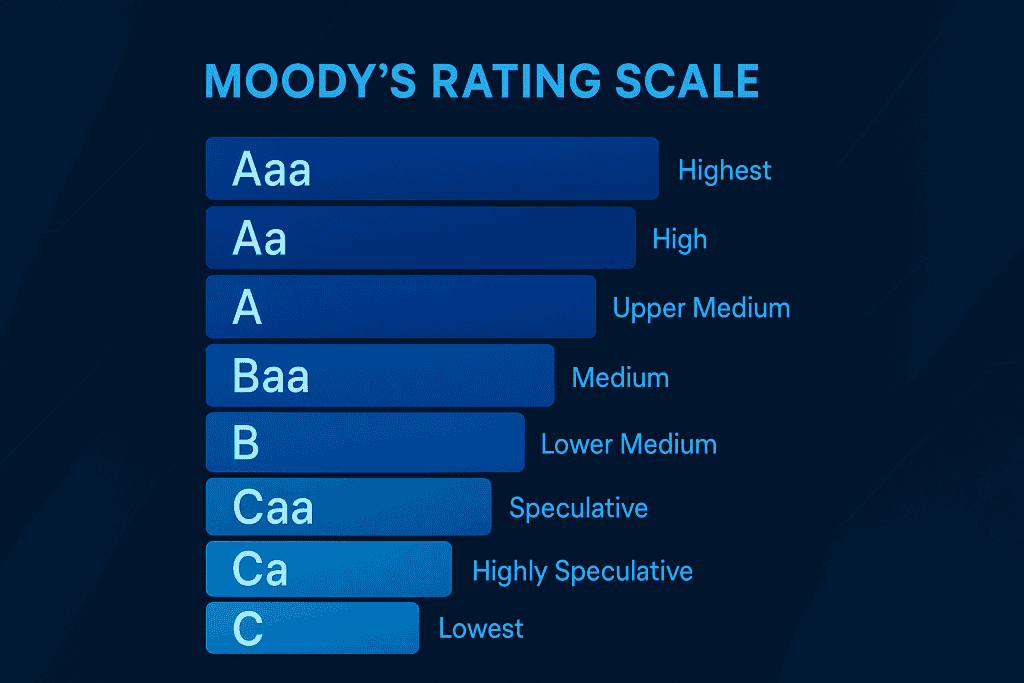
Imagine lending money to a friend. If they’ve always paid you back on time, you’d feel confident lending to them again, right? But if they’ve missed a few payments, you’d probably hesitate. Now, scale that up to an entire economic system, and that’s where Moody’s Rating Scale comes in—it assesses the creditworthiness of governments, businesses, and institutions, helping investors gauge the risk before lending or investing.
Moody’s Rating Scale is one of the most trusted tools in global finance, helping investors and businesses assess risk before making big financial moves. But why does it matter, and how does it affect your money? Let’s dive in.
What Happened?
Recently, Moody’s made headlines by adjusting the credit ratings of several major economies and corporations. These changes signal shifting financial conditions and can influence everything from interest rates to stock market performance.
Moody’s assigns ratings ranging from Aaa (the best) to C (the worst), helping investors gauge the likelihood of a borrower repaying debt. When Moody’s upgrades a rating, it’s a positive signal—suggesting strong financial health. A downgrade, however, raises red flags, indicating potential financial struggles.
For example, a recent downgrade of a country’s credit rating could mean higher borrowing costs for its government, impacting businesses and everyday citizens.
When and Where?
These rating updates happen regularly as Moody’s assesses financial markets worldwide. Recent adjustments have focused on major economies like the U.S., China, and European nations, along with corporations in tech, banking, and real estate.
The timing of these updates is crucial. A downgrade during economic uncertainty can trigger panic, while an upgrade during recovery can boost investor confidence.
Who is Involved?
Moody’s Investors Service, a division of Moody’s Corporation, is the key player behind these ratings. Established in 1909, it has become a cornerstone of global finance.
Governments, corporations, and financial institutions closely follow Moody’s ratings, as they directly impact borrowing costs, investment decisions, and economic policies. Investors, both big and small, rely on these ratings to guide their financial choices.
Why It Matters
Moody’s Rating Scale isn’t just about numbers—it affects real people. A downgrade of a country’s credit rating can lead to higher interest rates on government debt, which often trickles down to businesses and consumers through higher loan rates.
For businesses, a lower rating means they might struggle to secure funding, leading to potential job cuts or slowed growth. On the flip side, an upgrade can boost investor confidence, leading to lower borrowing costs and economic expansion.
For individual investors, these ratings serve as a guide. If you’re investing in bonds, you want to know how safe your investment is. Moody’s helps provide that clarity.
Quotes or Statements
Moody’s recently commented on its rating adjustments, stating:
“Our decisions reflect evolving economic conditions and financial stability risks. While some markets remain resilient, others face growing fiscal pressures.”
Financial analysts also weighed in, with one expert noting:
“A downgrade isn’t just a technical change—it can shake markets and influence policy decisions at the highest levels.”
Conclusion
Moody’s Rating Scale plays a vital role in shaping the financial landscape. Whether you’re a government planning economic policy, a corporation seeking investment, or an individual looking for a safe investment, these ratings matter.
As financial markets evolve, expect more shifts in Moody’s ratings. Staying informed about these changes can help you make smarter financial decisions and navigate the complexities of the global economy.
What do you think? Have you ever made an investment decision based on a credit rating? Let’s discuss in the comments!
Resources
- Financial Edge Training- Moody’s – Definition, How it Works, Credit Ratings Scale
- Moneyland- S&P, Moody’s, Fitch Rating Comparison
- Wolf Street- Corporate Bond Credit Ratings Scales: Moody’s, S&P, Fitch
- Investopedia- Credit Rating: Definition and Importance to Investors
- State of Idaho- Moody’s Rating Symbols & Definitions
